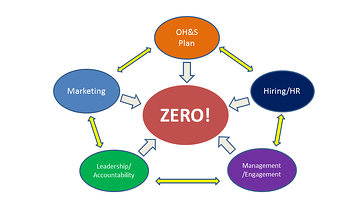5 Parts to Zero-Safety: Why The 80-20 Rule Is Preventing Zero
The 80/20 Rule, The Pareto Principle, may be the exact reason you can't seem to hit Zero in safety and consistently hold it there. What you might think is the problem, is not actually the problem.

Safety is not something you do or manage; it is the result of five things done right. Unfortunately, the focus for achieving Zero has historically been solely on the OH&S part. But it is only one-fifth, or twenty percent, of what needs to be addressed.
Why The Safety Department Can't Fix Safety
Safety managers lack the expertise to deal with the other eighty percent of the organizational issues because:
- they don't recognize how the other eighty percent has a direct bearing on unsatisfactory safety records
- they have no experience or knowledge of the non-OH&S contributing factors to safety performance.
So instead, safety managers do what they have always done: they try to squeeze more juice from their compliance model wrongly assuming that more compliance will result in fixing the problem. But it doesn't because compliance is not the issue.
Here are the five parts of how to achieve Zero in safety
1OH&S Plan - no secret here, the safety plan plays a critical role in the achievement of attaining Zero. The safety plan has to be near bullet-proof and has to have good auditing, safety training, safety culture and employee commitment to looking out for one another. Safety compliance must also leave some room for the gray areas of safety - trusting workers to improvise to achieve safety - without taking risky shortcuts. But the safety plan is ONLY one-fifth of getting employees to buy-in to safety.
2Management/Engagement - an employee not engaged in their work and mindlessly and robotically going through the motions of their work is not buying-in to safety. Over 70% of employees in North America (according to Gallup) are not fully engaged in their work. That spells trouble for safety performance. Safety managers and supervisors, engagement just became your problem. Companies MUST get their safety managers and supervisors into management and coaching training courses now. A manager who can't inspire nor motivate their employee to engage in their work and buy-in is as great a job-hazard as the employee who isn't paying attention.
3Hiring/Human-Resources - if over 70% of workers are not fully engaged, then that means 7 out of every 10 new job hires are somehow sneaking past the HR department. Human Resources, as a profession, needs an overhaul. New technology is not weeding out the disengaged. Do not let a lone HR person pick your next employee, unless they have demonstrated that they understand, comprehend and embrace safety as one of their own personal values. You can't pick a good safety performer, one who will buy-in to safety, if you don't embrace safety as one of your own personal values.
4Leadership/Accountability - leadership in this sense means at a personal level. Leadership is an attitude - management is a position. Anyone can possess leadership skills. It is your responsibility to pick people of strong character and personal leadership as employees who will buy-in to safety. If you pick anyone else, you run the risk of imperfect safety performance. People who understand that they are accountable and responsible for every action they take and every decision they make are the kinds of people you want in your workplace. People who want to blame everyone else for their circumstances are in victim-mentality. Victims don't buy-in to safety.
5Marketing - marketing to outside customers is the same function as is marketing to inside customers (employees). You are, after all, trying to convince them to buy-in to your safety program and safety culture. It takes a planned, professionally produced approach to getting employees into buying safety for themselves. Generic safety slogans don't work. "Be Safe" is a terrible safety message as are campaigns that look ripped from the pages of Dr. Seuss books. Safety campaigns must be personal, focused and encourage behaviours and values aligned with safety goals. And the safety message must permeate the entire organization - in every department - everywhere an employee looks.
Failure to deliver on any of the five parts of the Zero Strategy will halt safety buy-in and ultimately, optimum performance. Safety is not an add-on. It is the foundation upon which your organization must build itself. Ask how I can help you implement the five parts in your organization.



